Raymarine introduces thermal cameras, but FLIR Nexus still open
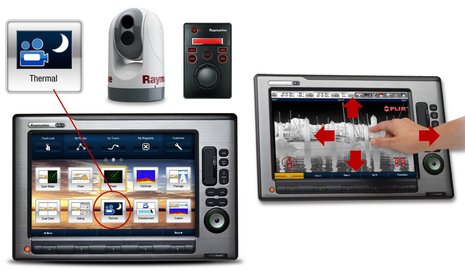
Given that FLIR, the big daddy of thermal imaging, purchased Raymarine in May, few will be surprised that Ray is introducing its own thermal cams. In fact, I think the Raymarine T300 and T400 model series will simply be re-branded FLIR M-Series cameras, though the control and integration possibilities are interesting. For owners of Raymarine E Wide and G Series MFDs, the joystick control above will be optional; the first group will be able to pan and tilt the camera using their touch screens, as shown, while the latter can use a G's detached keyboard. And while the short initial press release doesn't say anything about niceties like automated target tracking, we already know that the Nexus operating system FLIR builds into these cameras offers such capabilities...
When I met with FLIR and Raymarine representatives recently, I asked if FLIR had changed its mind about encouraging all MFD and PC charting developers to use Nexus tools offered by its networking division to build in camera integration, an attractive concept announced at the Miami show in February and demonstrated there in MaxSea TimeZero. The answer was an emphatic no; FLIR pointed out that its overall business model has long walked the delicate line of both supplying and competing with such developers, and the Raymarine acquisition hasn't changed that. And, sure enough, a listed new feature of MaxSea TZ 1.9 is a level of M-Series control and camera view visualization that may exceed what Raymarine starts off with...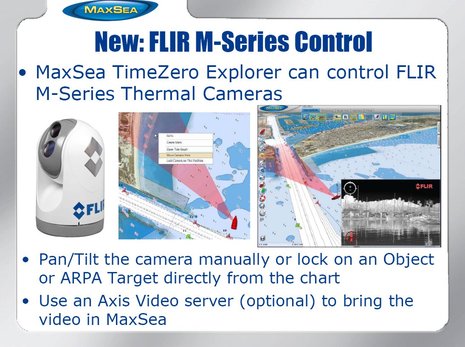 But I also came out of that meeting with some images which suggest just how powerful Nexus is, and...
But I also came out of that meeting with some images which suggest just how powerful Nexus is, and...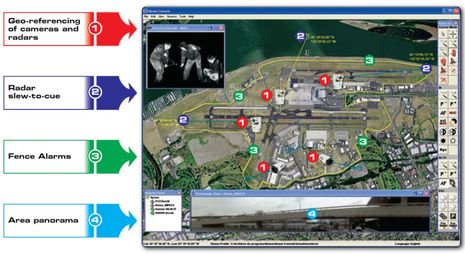 how deeply embedded into future Raymarine vessel systems it's envisioned to go:
how deeply embedded into future Raymarine vessel systems it's envisioned to go: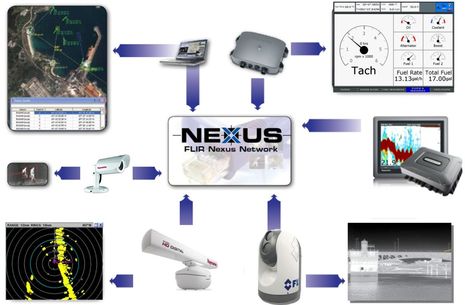 Frankly, I don't completely understand what the diagram above means, but it helps if you listen to the interview MadMariner did with FLIR's Andy Teich. Meanwhile, the graph below is fairly easy to comprehend, even if it seems radical today. FLIR believes that the history of thermal cameras will go like GPS, from expensive novelty to must-have equipment, and even thinks that they'll become more popular than radars (though not replacing them). If today radar is the third most common major electronics item, on about 45% of the boats that already have MFDs, FLIR believes that thermal will one day reach 50% penetration, and it doesn't seem all that important to them whose labels go where.
Frankly, I don't completely understand what the diagram above means, but it helps if you listen to the interview MadMariner did with FLIR's Andy Teich. Meanwhile, the graph below is fairly easy to comprehend, even if it seems radical today. FLIR believes that the history of thermal cameras will go like GPS, from expensive novelty to must-have equipment, and even thinks that they'll become more popular than radars (though not replacing them). If today radar is the third most common major electronics item, on about 45% of the boats that already have MFDs, FLIR believes that thermal will one day reach 50% penetration, and it doesn't seem all that important to them whose labels go where.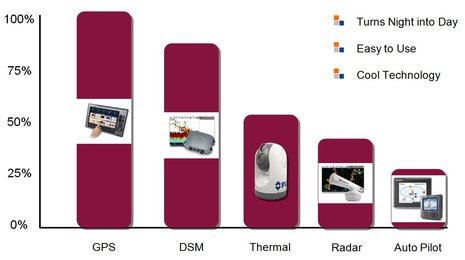

 Share
Share
The new Raymarine Thermal camera systems are esentially the FLIR M-series. These are awesome cameras that do far more than their cousins the Mariner or Navigator.
Besides the higher resolution, they can also zoom-in in Thermal mode. Also the higher level camera has a second camera that is for low-light use. Even near dark, as long as there is some ambient light around, the low-light camera provides incredible images.
The Valkyrie had one equipped for testing on a recent outing with the Channel Islands Sea Ray Club trip to San Francisco and back. At dock we could use the camera to see hundreds of sea lions at Pier 39 in front of the boat. At the same time Alcatraz and the marina enterance were clearly visible even without any moon.
Yes these items are pricy and as technology increases, the prices should decrease. A number of people have told me that they have no interest in buying the thermal cameras because they don't travel at night. However, the low-light camera is awesome even in the day especially dawn and dusk. Also, thermal cameras are excellent for use when traveling directly into the sun as they do not see the blinding rays and can show on-coming vessels.
Much like AIS, these items will take a while for the "typical" boater to understand uses for them other than specialty situations. However, as with all technology, that time will come quickly.
The software is not out just yet to pan and tilt using the E-wides, but it is soon to be released. In the meantime, the joy stick is easy to use.
Integration with radar and chartplotters, gyro stabilization, etc, will come. Some of this is already available with their even higher end equipment ($70,000 and up).
They are pretty impressive cameras.